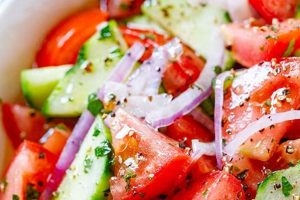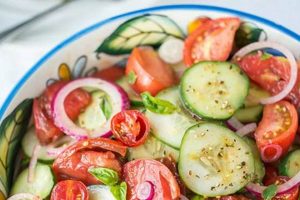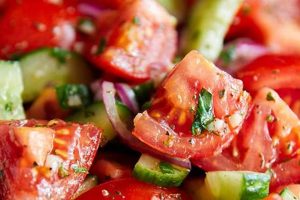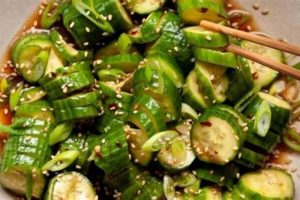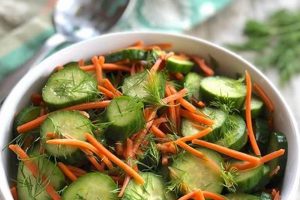A guide for preparing a dish of sliced cucumbers, typically combined with fresh dill and a vinegar-based dressing, constitutes the core of this subject. Variations may include additional ingredients like onions, sour cream, or garlic, offering a refreshing and light culinary experience. A simple example includes thinly sliced cucumbers tossed with chopped fresh dill, white vinegar, sugar, salt, and pepper.
Cool and crisp, this type of salad offers a healthy and flavorful complement to richer meals, particularly during warmer months. Its simple preparation makes it a popular choice for both everyday meals and more formal occasions. Historically, cucumbers and dill have been paired in various culinary traditions, reflecting their complementary flavors and shared growing seasons. This combination provides a good source of vitamins and minerals, contributing to a balanced diet.
Further exploration will delve into specific ingredient selections, preparation techniques, and variations to customize this versatile dish, offering a range of options from classic simplicity to more complex flavor profiles.
Tips for a Perfect Cucumber Salad with Dill
Optimizing ingredient selection and preparation techniques elevates this simple salad from refreshing to exceptional. Attention to detail ensures a balanced flavor profile and desirable texture.
Tip 1: Salt the cucumbers and allow them to drain. This draws out excess moisture, preventing a watery salad. Place sliced cucumbers in a colander with salt for at least 15 minutes before rinsing and drying.
Tip 2: Use fresh dill. Dried dill lacks the vibrant flavor and aroma crucial for this salad. Finely chop fresh dill just before adding to maximize its impact.
Tip 3: Balance the dressing. Achieve the perfect balance of sweet and tart flavors in the dressing. Adjust the ratio of vinegar and sugar according to personal preference. Consider a touch of Dijon mustard for complexity.
Tip 4: Choose the right vinegar. White vinegar offers a clean, crisp acidity. Apple cider vinegar provides a slightly sweeter, fruitier note. Experiment to discover preferred flavor profiles.
Tip 5: Thinly slice the cucumbers. Evenly thin slices ensure consistent flavor distribution and a pleasant texture. A mandoline slicer offers optimal precision.
Tip 6: Chill before serving. Allowing the salad to chill in the refrigerator for at least 30 minutes allows the flavors to meld and enhances the refreshing quality.
Tip 7: Consider additions. Thinly sliced red onion adds a pungent bite. A dollop of sour cream or Greek yogurt contributes creaminess. Minced garlic provides a subtle savory note.
By following these guidelines, one can achieve a cucumber salad with dill that is both flavorful and texturally satisfying. Careful preparation maximizes the refreshing qualities of this simple dish.
The following section will explore variations and serving suggestions to further enhance the enjoyment of this classic salad.
1. Fresh Dill
Fresh dill stands as a cornerstone of a successful cucumber salad. Its vibrant, grassy aroma and subtly sweet, anise-like flavor provide a crucial counterpoint to the cool, mild cucumber. Dried dill, while a convenient alternative in some dishes, lacks the essential aromatic oils that characterize fresh dill, resulting in a significantly diminished flavor profile. This distinction profoundly impacts the overall sensory experience of the salad. A cucumber salad prepared with dried dill often tastes flat and lacks the characteristic brightness derived from fresh herbs. Consider, for example, a classic Scandinavian cucumber salad, where the interplay of fresh dill and cucumber defines the dish. Substituting dried dill would compromise its authenticity and culinary impact.
The practical significance of using fresh dill extends beyond flavor. Fresh dill contributes a vibrant green hue and delicate texture, enhancing the visual appeal of the salad. Its feathery fronds offer a pleasing contrast to the smooth cucumber slices. Furthermore, fresh dill provides nutritional benefits, including vitamins A and C, which are largely lost in the drying process. For instance, a summer luncheon featuring cucumber salad benefits significantly from the fresh dill’s vibrant color and refreshing aroma, contributing to the overall dining experience. The choice between fresh and dried dill, therefore, represents a critical decision, impacting not only the flavor but also the aesthetic and nutritional value of the dish.
In summary, fresh dill plays a pivotal role in defining the characteristic flavor profile, visual appeal, and nutritional value of cucumber salad. While dried dill offers convenience, it cannot replicate the essential qualities imparted by fresh dill. Understanding this distinction allows for informed ingredient selection, ultimately leading to a more satisfying culinary outcome. Overlooking this detail can compromise the overall quality and authenticity of the dish, highlighting the essential role of fresh dill in a truly successful cucumber salad.
2. Thinly Sliced Cucumbers
Thinly sliced cucumbers constitute a critical element within a cucumber salad with dill recipe. This preparation method impacts flavor absorption, texture, and overall presentation. Thin slices offer a greater surface area, allowing the dressing to permeate the cucumber more effectively, resulting in a more flavorful and evenly seasoned salad. A thicker cut, conversely, can lead to an imbalance, with the exterior saturated while the interior remains bland. This principle applies to other marinated salads, such as quick-pickled onions, where thin slices ensure rapid and complete flavor infusion. The increased surface area also allows the delicate dill flavor to meld more seamlessly with the cucumber.
Beyond flavor, the thinness of the cucumber slices contributes significantly to textural appeal. Thin slices provide a delicate crunch, readily yielding to the bite. Thicker slices, on the other hand, can offer a less pleasant, almost rubbery texture, detracting from the overall sensory experience. This is particularly relevant in the context of a cucumber salad with dill, where a refreshing, crisp texture is paramount. Imagine a classic afternoon tea featuring delicate finger sandwiches and a side of cucumber salad. Thickly cut cucumbers would disrupt the delicate balance of textures, while thinly sliced cucumbers offer a harmonious complement. The thinness also promotes even distribution throughout the salad, ensuring a consistent experience with each bite.
Finally, thinly sliced cucumbers contribute significantly to the aesthetic presentation of the salad. Uniformly thin slices create a visually appealing arrangement, conveying care and precision in preparation. This visual aspect enhances the perceived quality and enjoyment of the dish. Consider a catered event where presentation plays a key role; thinly sliced cucumbers elevate the perceived sophistication of even a simple cucumber salad. The thin slices also allow for greater flexibility in plating, enabling more intricate and elegant presentations. Therefore, the thickness of cucumber slices, a seemingly minor detail, profoundly influences the flavor, texture, and presentation of the salad, underscoring its crucial role in a successful cucumber salad with dill recipe.
3. Balanced Vinegar Dressing
A balanced vinegar dressing forms the foundation of a successful cucumber salad with dill recipe. Its delicate interplay of acidity, sweetness, and other complementary flavors elevates the simple ingredients, transforming them into a cohesive and refreshing dish. The dressing’s balance prevents the salad from becoming overly tart or excessively sweet, allowing the subtle flavors of the cucumber and dill to shine through. Understanding the components of a balanced dressing and their interplay is crucial for achieving optimal results.
- Acidity
Vinegar provides the essential acidic component, cutting through the mildness of the cucumbers and adding brightness to the overall flavor profile. Different vinegars offer varying levels of acidity and subtle flavor nuances. White vinegar provides a clean, crisp acidity, while apple cider vinegar lends a slightly sweeter, fruitier note. The choice of vinegar influences the final flavor profile, necessitating careful selection based on desired outcomes. Too much acidity can overwhelm the delicate cucumber and dill, while too little can result in a bland salad.
- Sweetness
Sugar or a similar sweetener balances the acidity of the vinegar, creating a harmonious flavor profile. The sweetness level should complement the vinegar’s tartness without dominating the overall taste. Granulated sugar, honey, or maple syrup can serve as sweeteners, each contributing unique subtle flavors. For instance, honey adds a floral note, while maple syrup imparts a subtle caramel undertone. The balance between sweetness and acidity determines the dressing’s overall character.
- Seasoning
Salt and pepper enhance the flavors of the other ingredients and provide depth to the dressing. Salt balances the sweetness and acidity while pepper adds a subtle bite. The correct seasoning level is crucial; too much salt can make the salad unpleasantly salty, while insufficient seasoning can result in a flat, uninteresting flavor. Other seasonings, such as garlic powder or onion powder, can further enhance the complexity of the dressing, though moderation is key to avoid overpowering the delicate cucumber and dill.
- Emulsification
While not strictly essential, an emulsified dressing, often achieved by whisking in a small amount of oil, creates a creamy texture and helps the dressing cling to the cucumbers. This results in a more cohesive and visually appealing salad. The oil also contributes to a richer mouthfeel and can carry additional flavor nuances, such as those from infused oils. However, the amount of oil should be minimal to avoid a heavy, greasy salad that masks the freshness of the cucumbers and dill.
The careful balance of these components acidity, sweetness, seasoning, and emulsification determines the overall success of the cucumber salad with dill recipe. A well-balanced dressing enhances the natural flavors of the ingredients, creating a refreshing and harmonious dish. The interplay of these elements highlights the importance of a thoughtfully crafted dressing in elevating a simple cucumber salad from ordinary to exceptional. Understanding these principles allows for customization and adaptation to suit individual preferences, creating a versatile and consistently satisfying culinary experience.
4. Salting and Draining Cucumbers
Salting and draining cucumbers constitutes a crucial preparatory step in a cucumber salad with dill recipe. This process addresses the inherent high water content of cucumbers, which, if left unmanaged, can lead to a diluted dressing and a watery, less palatable salad. Osmosis, the movement of water across a semipermeable membrane from an area of high concentration to an area of lower concentration, plays a key role in this process. Sprinkling salt on sliced cucumbers creates a hypertonic environment, drawing water out of the cucumber cells and into the surrounding salt solution. This process not only removes excess moisture but also concentrates the cucumber’s flavor. Failing to execute this step risks compromising the overall texture and flavor balance of the final dish. Consider, for example, a picnic setting where a watery cucumber salad would be less appealing and potentially soak into other food items. The salting and draining process safeguards against this undesirable outcome.
The practical implications of this understanding extend beyond mere moisture removal. Salting and draining contributes to a crisper cucumber texture, enhancing the overall sensory experience. The removal of excess water allows the dressing to adhere more effectively to the cucumber slices, ensuring a more flavorful and evenly coated salad. Furthermore, this process can improve the salad’s shelf life by reducing the amount of free water available for bacterial growth. In a restaurant setting, for instance, this step becomes critical for maintaining food quality and minimizing waste. The seemingly simple act of salting and draining thus offers multiple benefits, contributing significantly to the final product’s quality and overall enjoyment. Culinary traditions across various cultures often incorporate similar techniques, highlighting the universal understanding of moisture management in vegetable preparation.
In summary, salting and draining cucumbers is a critical, albeit often overlooked, element in a cucumber salad with dill recipe. Understanding the scientific principles behind this process, specifically osmosis, underscores its importance in achieving a desirable texture and flavor profile. The practical implications of this understanding extend to food preservation, presentation, and overall culinary success. Failure to execute this step can compromise the final dish, highlighting the seemingly small details’ significant impact on culinary endeavors. This principle extends beyond cucumber salads, applying to a wider range of vegetable preparations where moisture control is paramount.
5. Chilling Before Serving
Chilling a cucumber salad with dill prior to serving significantly enhances its sensory qualities and overall appeal. Temperature influences flavor perception; chilling dulls bitterness while accentuating sweetness and acidity. In the specific case of cucumber salad with dill, chilling amplifies the refreshing qualities of the cucumbers and the bright, herbaceous notes of the dill. This effect stems from the temperature’s impact on volatile aromatic compounds, making them more perceptible. A chilled salad offers a welcome contrast to richer, heavier dishes, particularly in warm weather. Imagine a summer barbecue where a chilled cucumber salad provides a refreshing counterpoint to grilled meats. This practice aligns with culinary traditions in various cultures, reflecting a universal appreciation for the sensory enhancement achieved through temperature control.
Beyond flavor enhancement, chilling influences texture. Lower temperatures firm the cucumber slices, contributing to a desirable crispness. This contrasts with room-temperature cucumbers, which can become slightly soft and less appealing. The chilling process also allows the flavors of the dressing to meld more thoroughly with the cucumbers and dill, creating a more cohesive and harmonious flavor profile. In a buffet setting, for instance, where salads may sit for extended periods, chilling becomes crucial for maintaining both flavor and texture. Furthermore, chilling slows down enzymatic activity, which can lead to undesirable changes in flavor and texture over time. This factor becomes increasingly important in professional kitchens where salads may be prepared in advance.
In conclusion, chilling a cucumber salad with dill before serving constitutes a critical step that elevates both its sensory characteristics and overall quality. Temperature’s influence on flavor perception and texture underscores the importance of this practice in achieving a truly refreshing and satisfying culinary experience. Practical applications, ranging from casual picnics to formal catered events, demonstrate the broad relevance of this understanding. The integration of scientific principles with culinary practice underscores the multifaceted nature of food preparation and its impact on the final product. This attention to detail distinguishes a thoughtfully prepared dish from a merely adequate one.
6. Optional additions (onions, yogurt)
Optional additions, such as onions and yogurt, offer avenues for customization and flavor complexity within a cucumber salad with dill recipe. These additions, while not essential to the core definition of the dish, provide opportunities to tailor the flavor profile and textural experience to specific preferences or culinary goals. Onions, specifically red onions due to their sharpness and color contrast, introduce a pungent, slightly sweet element that balances the cool cucumber and herbaceous dill. This addition provides textural complexity, adding a crisp bite to the otherwise tender salad. Yogurt, particularly Greek yogurt due to its thick consistency and tangy flavor, introduces a creamy element that complements the refreshing qualities of the cucumber and dill. The yogurt’s tanginess also adds depth to the flavor profile, contrasting with the subtle sweetness often present in the dressing. Consider a Mediterranean-inspired meal where a cucumber salad with red onion and yogurt provides a cooling counterpoint to richer, spicier dishes. The choice of additions allows the salad to harmonize with a wider range of accompanying foods and culinary traditions.
The strategic use of optional additions provides a means of balancing flavors and textures within the overall composition of the dish. The sharpness of red onion, for example, can offset an overly sweet dressing, while the creaminess of yogurt can balance an excessively acidic vinegar base. Such additions also offer opportunities for visual enhancement. The vibrant purple hue of red onion provides an appealing contrast to the green of the cucumbers and dill, while the white of the yogurt adds a touch of elegance. In a formal dining setting, these visual details can elevate the perceived sophistication of the dish. Furthermore, optional additions can introduce nutritional benefits. Onions are a good source of antioxidants, while yogurt provides probiotics and protein. These nutritional considerations can influence ingredient selection, particularly when aiming for a health-conscious meal plan. For example, a cucumber salad featuring yogurt and red onion served alongside grilled fish offers a balanced and nutritious meal.
In summary, optional additions like onions and yogurt offer significant potential for customization and enhancement within the framework of a cucumber salad with dill recipe. These additions facilitate flavor balancing, textural variation, visual appeal, and nutritional enhancement. Understanding the role and impact of these additions allows for informed decision-making, enabling culinary practitioners to tailor the dish to specific needs and preferences. While respecting the core essence of the dish, these additions offer flexibility and creativity, transforming a simple salad into a more complex and nuanced culinary experience. This principle of customization extends to other dishes, highlighting the potential of optional ingredients to elevate and personalize culinary creations.
7. Proper Storage Techniques
Proper storage techniques are essential for maintaining the quality and extending the lifespan of cucumber salad with dill. This dish, characterized by its fresh, crisp, and vibrant components, is particularly susceptible to deterioration if not stored correctly. The high water content of cucumbers makes the salad prone to spoilage and textural degradation. Improper storage can lead to bacterial growth, resulting in off-flavors and potential food safety concerns. Furthermore, exposure to air can cause the cucumbers to dry out and the dill to wilt, diminishing the salad’s visual appeal and flavor. Effective storage practices mitigate these risks, preserving the intended culinary experience. For instance, a restaurant preparing cucumber salad in advance for a catered event must employ proper storage to ensure the salad remains fresh and appealing until served. This understanding translates directly to home kitchens, where proper storage maximizes the enjoyment and value of prepared dishes.
Optimal storage involves placing the salad in an airtight container in the refrigerator. The airtight seal minimizes exposure to oxygen, preventing oxidation and preserving the vibrant green color of the dill. It also inhibits moisture loss, maintaining the cucumbers’ crisp texture. Refrigeration further slows down enzymatic activity and bacterial growth, extending the salad’s shelf life. The container should be appropriately sized to minimize excess air space, further reducing the risk of oxidation and moisture loss. Avoid storing the salad near strong-smelling foods, as cucumbers can readily absorb odors, compromising the delicate flavor balance. In a professional kitchen setting, proper labeling and dating of stored containers ensures efficient stock rotation and minimizes food waste. Similarly, in a home environment, adhering to these practices ensures food safety and maximizes the value of fresh ingredients. The practical application of these principles directly influences the overall quality and enjoyment of the dish.
In summary, proper storage techniques are integral to maximizing the quality and longevity of cucumber salad with dill. The delicate nature of this dish necessitates careful attention to storage practices to preserve its intended flavor, texture, and visual appeal. Effective storage, primarily through the use of airtight containers and refrigeration, mitigates the risks of spoilage, oxidation, and moisture loss. This understanding translates directly to practical applications in both professional and home kitchens, ensuring a consistently satisfying culinary experience. Failure to adhere to these practices can compromise the dish’s quality, highlighting the significant impact of proper storage within the broader context of culinary arts.
Frequently Asked Questions
This section addresses common inquiries regarding cucumber salad with dill preparation and storage, offering practical guidance for optimal results.
Question 1: How long can cucumber salad with dill be stored in the refrigerator?
Properly stored in an airtight container, cucumber salad with dill typically maintains optimal quality for three to five days in the refrigerator. Beyond this timeframe, texture and flavor may degrade.
Question 2: Can this salad be prepared in advance?
Preparation in advance is possible. However, optimal flavor and texture are achieved when served within a few hours of preparation. For longer storage, follow recommended refrigeration guidelines.
Question 3: What type of vinegar is best suited for the dressing?
White vinegar offers a clean, crisp acidity. Apple cider vinegar introduces a subtly sweet, fruitier note. Selection depends on individual preference and desired flavor profile.
Question 4: Is it necessary to salt and drain the cucumbers?
Salting and draining cucumbers removes excess moisture, preventing a watery salad and promoting a crisper texture. This step significantly contributes to the overall quality of the final dish.
Question 5: Can dried dill be substituted for fresh dill?
While dried dill can be used in some dishes, it lacks the vibrant flavor and aroma crucial for this particular salad. Fresh dill is strongly recommended for optimal results.
Question 6: Can other herbs be added to the salad?
While dill is the defining herb in this salad, other herbs, such as parsley, mint, or chives, can be added in small quantities to complement the dill and introduce subtle flavor nuances.
Understanding these frequently asked questions ensures consistent and successful preparation of cucumber salad with dill, allowing for adaptation and customization while preserving the core elements that define this refreshing dish.
The following section will explore variations of this classic recipe, expanding culinary possibilities.
Recipe for Cucumber Salad with Dill
Exploration of this subject has illuminated the critical elements contributing to a successful outcome. Emphasis on fresh dill, thinly sliced cucumbers, a balanced vinegar dressing, and the crucial salting and draining process underscores the importance of precise execution. Chilling before serving enhances sensory qualities, while optional additions like onions and yogurt offer avenues for customization. Proper storage techniques preserve the intended freshness and flavor profile, maximizing the dish’s longevity. Understanding these components allows for both classic interpretations and creative adaptations, reflecting the dish’s versatility.
This seemingly simple preparation offers a canvas for culinary expression, highlighting the significant impact of precise technique and thoughtful ingredient selection. Further exploration of culinary traditions and flavor pairings promises to unlock continued innovation within this classic dish, enriching gastronomic experiences.

